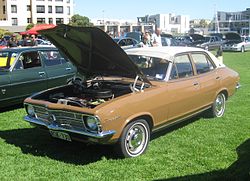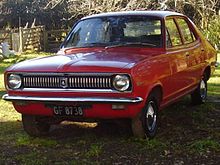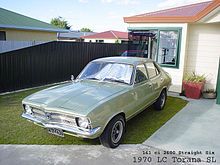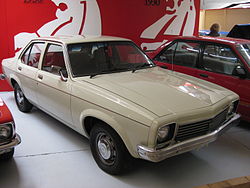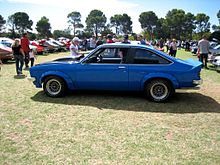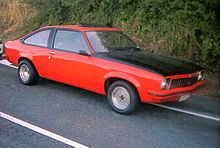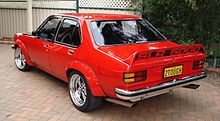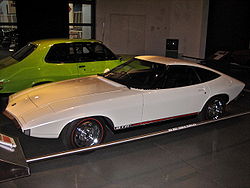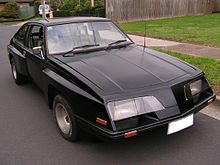- Holden Torana
-
Holden Torana 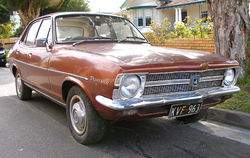 1969-1972 Holden LC Torana SL sedan.
1969-1972 Holden LC Torana SL sedan.Manufacturer Holden Also called Holden Sunbird Production 1967–1979 Successor Holden Camira Class Compact car/Mid-size car The Holden Torana is a car which was produced by General Motors–Holden's (GM-H), the Australian subsidiary of General Motors (GM) from 1967 to 1980. The name comes from an Aboriginal word meaning "to fly". The first Torana (HB series) appeared in 1967 and was a four cylinder compact vehicle that had its origins in the British Vauxhall Vivas of the mid 1960s. Whilst 1969-73 (LC and LJ) models included more popular, longer wheel base six cylinder versions; and 1974-77 (LH and LX) eight cylinder versions the four-cylinder versions continued for the entire production life of the Torana and were known as the Holden Sunbird from 1976.
Responding to the dominance of Australian motor sport by Ford Australia, Holden released the GTR XU1 Torana in 1970, with a performance enhanced drive train and handling. From this time through to the release of the Holden Commodore, the Torana remained Holden's most successful sports/performance vehicle.
With the introduction of the Commodore in 1978 the eight cylinder Torana was discontinued and in 1979, the Torana in its final guise (UC six cylinder)was also phased out, followed by the four cylinder Sunbird in 1980.
In South Korea the LJ Torana was produced locally as the Chevrolet 1700 (시보레 1700, 1972–1978) and Saehan Camina (새한 카미나, 1976–1978).
Contents
First generation
HB
HB Torana 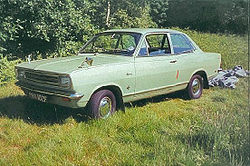
1966–1970 Vauxhall Viva HB (related to the HB Torana)Production 1967–1969 Body style 2-door sedan
4-door sedanLayout FR layout Engine 1.2 L OHV I4 Introduced in May 1967 to replace the HA series Vauxhall Viva in the Australian market, the first Torana model was a facelifted HB series Vauxhall Viva. It featured a two-door body, 12 inch (305 mm) wheels and a 56 bhp 1.2 litre four-cylinder engine mated to a four-speed gearbox. A Borg-Warner Model 35 three speed automatic transmission was optional. Drum brakes were fitted front and rear, with power assisted front disc brakes optional.
In early 1968 a "Series 70" engine option was added. This engine had a higher compression ratio, a higher lift camshaft, and a single CD Stromberg carburettor, which boosted output to 69 bhp (51 kW; 70 PS). Power assisted front disc brakes were standard when this engine was used, and the automatic transmission option was now no longer available with the standard 56 bhp (42 kW; 57 PS) engine. A 'sports' model was also released at the same time called the 'Brabham' Torana, named in honour of the well-respected Australian race-car driver, Sir Jack Brabham. The Brabham Torana's engine was based on the Series 70, but twin CD Stromberg carburettors with sports air cleaners were fitted. Together with the low restriction exhaust system, this boosted the power to 79 bhp (59 kW; 80 PS). The Brabham also included wider wheel rims and red-wall tyres, power assisted front disc brakes as standard, different badging and black body accents. Automatic transmission was not available on this model.
In September 1968, the '69 Torana' was released, sometimes called the HB Series II. This featured locally made body panels, replacing the imported bodies of the original HB. The model line up now included a 4-door sedan which was developed in Australia, with four-door bodies shipped back to the UK to be constructed and sold as the Viva. A collapsable steering column was now fitted, together with a new recessed instrument cluster, new indicator switch, and new steering wheel borrowed from the contemporary full-sized Holden. These local components replaced the previously imported Vauxhall items. A consequence of using these local components was the loss of the stalk operated headlight dip switch and horn. The dip switch ended up on the floor, as was the case for full-size Holdens. Dual circuit brakes were now standard on all models, though power assisted front disc brakes were still optional with the standard 56 bhp (42 kW; 57 PS) engine. The Brabham Torana was still available, in two door form only. It now included a sports steering wheel similar to the contemporary Holden Monaro GTS, full instrumentation, different badging, and different black accenting. The HB Torana continued until late 1969. Total production was 16,318 with imported panels and 20,243 with the locally manufactured bodies.
Second generation
LC
LC Production 1969–1972 Body style 2-door sedan
4-door sedanEngine 1.2L OHV I4
1.6L OHC I4
130 / 2.1L OHV I6 (Export motor)
138 / 2.25L OHV I6
161 / 2.6L OHV I6
173 / 2.85L OHV I6
186 / 3.0L OHV I6The next generation of Toranas (LC) appeared in October 1969 and were available with either a four or six cylinder engine. The inline six had a capacity of 138 in³ (badged as the '2250'). The six-cylinder cars had a longer wheelbase (100 inches against the 95.8 inches (2,430 mm) of four-cylinder models),[1] a more aggressively styled slightly longer nose to accommodate the larger engine, and offered a choice of three and four-speed manual gearbox or a three-speed Trimatic automatic transmission. The Torana was Wheels magazine's Car of the Year for 1969.
Body styles were all new and available in either two or four doors, and were offered in S or SL trim. Bench or bucket front seats were also an option, along with disc front brakes. A more-powerful 161 in³ engine (badged as the '2600') was made available soon after the model's release in the more upmarket SL and in the two-door sports model, the GTR, as a 2600S with a two-barrel Stromberg WW carburettor. Later in production, the 161ci engine was replaced with a larger 173ci version (badged as the '2850') which also made it into the last of the LC GTR cars in two-barrel form.
In 1970 the first genuine performance Torana, the GTR XU-1, was developed by Holden along with Harry Firth of the Holden Dealer Team for competition in popular Series Production racing series in Australia as well as in off-road rallying. However, the main purpose of the Torana GTR XU-1 was to keep Holden competitive against the big and powerful Ford Falcon GT-HO V8s in the Hardie-Ferodo 500 (Bathurst) endurance race that is considered to be the jewel in the crown of Australian motorsport.
The LC Torana GTR XU-1 was equipped with a 160 brake horsepower 186 in³ (3 litre) six cylinder engine, fitted with three Zenith Stromberg CD-150 carburettors, cast iron headers, a performance cylinder head and camshaft and an Opel four-speed manual gearbox. This car featured a rear spoiler, guard flutes, wider steel rims, full instrumentation and front disc brakes as standard. The Torana GTR XU-1 proved to be a strong performer both on the road and track due to its favourable power/weight ratio. It soon gained huge popularity in Australia, being an ideal race car in many forms of motor sport, especially Series Production touring car racing and rallying. It successfully replaced the V8 Monaro GTS 350 as Holden's frontline track race car in 1970, winning many touring car and rally events, but for the famed Bathurst 500-mile (800 km) race which Ford won in 1970 and 1971 with its XW Phase Two and XY Phase Three Falcon GT-HOs respectively.
General Motors-Holdens built a total of 74,627 LC Toranas.[2]
LJ
LJ 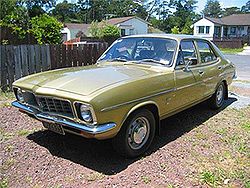
Also called Chevrolet 1700 (ROK)
Saehan Camina (ROK)Production 1972–1974 Body style 2-door sedan
4-door sedanEngine 1.2L OHV I4
1.3L OHV I4
1.6L OHC I4 (1972 only)
1.8L OHC I4 (late 1972-1974)
138 / 2.25L OHV I6
173 / 2.85L OHV I6
202 / 3.3L OHV I6In February 1972, the facelifted LJ Torana was introduced with the six-cylinder models now visually associated with the larger Holden HQ series. Many mechanical components were shared with the LC, with the major changes limited to the choice of engines. The four-cylinder Torana retained its 1200 & 1600 engines but was now also available with a 1300 cc unit. The 2250 and 2850 engines carried over into the revised six-cylinder Torana models, and the 3300 engine (known as the 202 in the HQ range) was adopted as the engine for the LJ Torana GTR sedan. Gearbox choices remained the same across the range.
A race-bred version of the 3300 engine was also fitted to the LJ Torana GTR XU-1, producing well over 200 brake horsepower. By now equipping the XU-1 with the 202ci engine and larger 1.75in CD triple carburettors, as well as a new close ratio M21 4-speed Australian made transmission, this gave the nimble XU-1 the power boost it needed to seriously challenge the powerful Ford Falcon GTHO Phase III, which had won the 1971 Hardie-Ferodo 500 production car endurance race held annually at Bathurst.
In the somewhat wet 1972 Hardie-Ferodo 500, the lightweight HDT Torana GTR XU-1 was able to finally claim victory against the heavyweight GT-HO, driven solo for 500 miles (800 km) by Peter Brock. This would be the start of the 'Peter Perfect'/Torana legend, and the first of five Bathurst wins for the Torana in its colourful ten year racing career at Bathurst.
Holden also developed a 308ci V8-powered version of the GTR XU-1, often referred to as the GTR XU-2, but the car never made it past the prototype stage. This was due to the 'Supercar Scare' of 1972, which involved vast political pressure being placed upon Holden, Ford and Chrysler to abandon their proposed specially-built 'Bathurst Supercars', such as the XU-2. This was the result of a media frenzy that was reporting against these soon-to-be released "bullets on wheels" available to the general public. In effect, all three manufacturers bowed to this pressure, and Holden would postpone its introduction of a V8 Torana for two years until the release of the slightly larger LH series Torana in 1974.
A total of 81,813 LJ Toranas were built by Holden in Australia, with some exported to New Zealand, but only in 6-cylinder form, likely due to the similar 4-cylinder Vauxhall Viva HC range being sold there as well. The 2850SL model, with bucket seats and 4-speed floor shift, or Trimatic three-speed automatic was also shipped to New Zealand in CKD kit form for local assembly from 1973, becoming the first Kiwi-built Torana.
The LJ Torana formed the basis of the Chevrolet 1700 in South Korea, produced by GM Korea (now GM Daewoo) between 1972 and 1976. Unlike the Torana, the 1700 was also available as a five-door station wagon. Powered by a 1,698 cc four-cylinder engine, the 1700 sold poorly in the Korean market with only 8,105 units produced; the car was perceived to suffer from high fuel consumption.[3]
Due to poor Chevrolet 1700 sales, the car was revised as the Camina in 1976 (General Motors Korea was renamed Saehan Motors in 1976). However, the Chevrolet version continued to sell alongside it until both models were discontinued in 1978. A smaller 1,492 cc engine was fitted to deliver better fuel economy than its Hyundai and Kia competitors, however, sales did not recover with only 992 cars sold in two years.[4] The 1700 and Camina replacement, the 1977 Saehan Gemini was a development of the Isuzu Gemini (sold in Australia as the Holden Gemini).[5]
TA
TA Production 1974–1975 Body style 2-door sedan
4-door sedanEngine 1.3L OHV I4
1.8L OHC I4In 1974 the six-cylinder LJ Torana was replaced by the new mid-size body six and eight cylinder LH Torana series. To fill in time before the March 1975 release of the four cylinder GM world T-car Holden Gemini, the short wheelbase 4-cylinder (1.3L & 1.8L) LJ models were given a basic facelift incorporating a body colour plastic moulded front grille assembly and revamped rear light lenses. This car was released in February 1974 on the Australian market only, in both two and four door forms, as the TA Torana. It was only produced for 11 months with a total production run of 11,304 units.[6]
Third generation
LH
LH 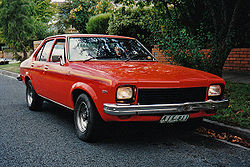
Production 1974–1976 Body style 4-door sedan Engine 1.9L OHV I4 (Opel unit)
173 / 2.85L OHV I6
202 / 3.3L OHV I6
253 / 4.2L OHV V8
308 / 5.0L OHV V8March 1974 saw the first completely new Torana body, with the arrival of the larger mid-sized LH series, produced in four door sedan style only. Despite the larger external size, the car was relatively cramped by mid-1970s standards. It resembled other GM products of its generation, notably the Opel Ascona. It was unique in that, following the addition of a 4 cylinder option in May 1974, the same body style was available with a choice of inline 4, inline 6, or V8 engines, specifically, 1.9 litre Opel four, 2.85 and 3.3 litre Holden 'red' sixes, and 4.2 and 5.0 litre Holden V8s.
The 5.0 litre engine was reserved for the sporting LH Torana SL/R 5000 sedan. A special build derivative of the SL/R 5000 was the Bathurst-intended 'L34 Option', of which only 263 were built, with a higher compression motor with stouter components for more power and durability in competition use. The most notable external feature of the L34 was the bolt-on wheel arch extensions, designed to accommodate the larger racing rims and tyres.[7]
The L34 proved to be fast and successful, yet fragile, in Australian touring car racing. It was eventually superseded by the evolutionary A9X option made available in the LX Torana series in 1977. The LH Torana in L34 form won the famed Bathurst 1000 touring car race with Peter Brock and Brian Sampson in 1975 and with Bob Morris & John Fitzpatrick in 1976.
Prototype wagon and hatchback versions of the LH Torana were built, but never reached production. Overall, a total of 70,184 LH Toranas were built.
New Zealand assembly got off to a troubled start. GMNZ, which still had a wide four-cylinder Vauxhall Viva/Magnum line on sale, had planned a 2850 six 'S' model with bench front seat and three-speed column manual shift and the 3300SL with bucket seats and four-speed manual or three-speed Trimatic floor shift. But the NZ government imposed a 60% sales tax (a post first oil crisis measure) on cars with engines over two litres just as GM launched the LH in mid-'74 and only a few of each were built. The LH was then withdrawn temporarily and relaunched some months later with the Opel 1.9-litre I4 and floor shift manual or auto (SL only) gearboxes. Six cylinder Toranas would never again be built in NZ and were only very rare imports after this. GMNZ also built a few unique local 'sports' special editions but the changes were only cosmetic.
LX
LX Also called Holden LX Sunbird Production 1976–1978 Body style 3-door hatchback
4-door sedanEngine 1.9L OHV I4
173 / 2.85L OHV I6
202 / 3.3L OHV I6
253 / 4.2L OHV V8
308 / 5.0L OHV V8The mildly facelifted LX series arrived in February 1976. Cosmetically, the most obvious changes were to replace the LH's rectangular headlights with round headlights, side window surrounds were changed from body colour to black, and the front Holden badge was enlarged. A two-door hatchback body was introduced as an alternative to the four-door sedan, although the 1,897 cc Opel unit was not offered in the new body style. Soon after its introduction, the LX was subjected to performance reducing engine modifications in order to comply with new mid-year emission regulations (ADR 27A).
LX Sunbird
When the LX Torana was introduced it featured a choice of four, six and eight cylinder engines. In November 1976 [8] the four-cylinder Torana was revised and relaunched as the Holden LX Sunbird.[9] From that point, the four cylinder models now powered by the locally produced Starfire Four (a crudely cut down version of the Holden six cylinder engine which also featured in the 1980 Toyota Corona and four cylinder versions of the Holden Commodore) were marketed as Sunbirds and the six or eight cylinder models as Toranas. The original LX series Sunbird was a single-trim range, with four-speed manual and three-speed automatic transmissions. There were minor trim differences compared to the Torana, notably the grille (with vertical bars) and distinctive chrome wheel covers. It was marketed as a four-door sedan and as a three-door hatchback.[10] The introduction of Sunbird also coincided with the first attempt by Holden to add a handling package to its range of cars. The introduction of 'radial-tuned suspension' (aka RTS) began with the LX Sunbird sedan and hatchback and then the LX Torana.
A9X option
During 1977, the LX series also saw the development of another limited build high-performance option aimed at winning in Australian Touring Car racing, and in particular at the annual Bathurst 1000 touring car race. This was the 'A9X Option' that was available on the 5.0 litre V8 powered SLR 5000 sedan and SS hatchback models.[11] The A9X visually resembled the L34 optioned LH model, but with the addition of a rear-ward facing bonnet scoop that was specially designed to increase airflow through the engine bay to produce maximum power in racing conditions. The A9X package varied from the old L34 in road form in that whilst the engine was not modified, the A9X nevertheless had some special mechanical features such as rear disc brakes, heavy duty axles and a heavy duty '10 bolt' differential.
After being rushed into racing service, the Torana A9X ultimately lost its debut Bathurst race in 1977 to the Ford Falcons of Allan Moffat and Colin Bond. However, the A9X package was soon refined and proved dominant during the following two seasons of touring car racing in Australia. A9X drivers Peter Brock and Bob Morris were victorious in the 1978 and 1979 Australian Touring Car Championships respectively and A9Xs shared by Peter Brock and Jim Richards won the Bathurst 1000 race in both years.
Overall a total of 65,977 LX Toranas were produced by Holden.
UC
UC 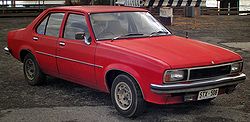
Production 1978–1980 Body style 3-door hatchback
4-door sedanEngine 1.9L OHV I4 (Sunbird)
173 / 2.85L OHV I6
202 / 3.3L OHV I6The introduction of the UC Torana in March 1978 saw the demise of V8 power and the cessation of the sporting SL/R variant in the Torana range of cars. The UC series featured a significantly modernised frontal appearance and a completely new interior dash layout. Torana was now rationalised to a choice of two equipment levels and two six-cylinder engines, the 2.85 litre and the 3.3 litre. A 'Deluxe Pack' was an option that allowed the UC Torana SL to compete with Ford's TE Cortina Ghia ... this comprised laminated windscreen, tinted side and rear windows, intermittent wipers, radio/cassette player, cloth trim, sports instrumentation and bumper overriders.
The Holden Sunbird was also updated to UC specifications and continued to sell well as a 1.9 litre four-cylinder car, sharing its body architecture with the UC Torana sedan and hatchback. The UC Sunbird expanded into three trim levels: base (manual only), SL and SL/E. It did very well in New Zealand, where it was assembled, particularly in fleets where it competed with the Ford Cortina and a variety of Japanese models. SL/E trim was also available in NZ. The UCs had square headlamps and a smoother front end. LX and early UC Sunbirds were fitted with a 1.9 litre Opel engine. Later UC models had a 1,892 cc 'Starfire' engine that was also installed into the Australian-produced versions of the Toyota Corona. The Hatchbacks were deleted in 1979, leaving only the sedans for the 1980 model year. The last Sunbird was built in September 1980.[12] The Sunbird was replaced initially by a four-cylinder version of the Holden Commodore, before the arrival of its natural successor, the Holden Camira, from 1982.
There was at one point design consideration of a five-door hatchback version of the UC Torana, which had a similar side profile to the Rover SD1 and rode an extended wheelbase. The idea never got past the clay modelling stage, probably in most part due to the impending introduction of the GM V-Car, the Commodore.
After release of the VB Commodore in November 1978, it soon became clear to GM-H that the Torana was too similar in size when compared to the more modern Holden Commodore. As a result, the UC Torana was soon dropped from the Holden range in 1979. The UC Sunbird continued through 1980 with a new locally manufactured 1.9 litre 'Starfire' engine (based on the 2.85 litre six) replacing the imported Opel unit.
For a while at least, there was talk of further extending the Torana/Sunbird's production life beyond 1980, with a facelifted 'UD' model, of which prototype models of the sedan and hatchback were actually built - featuring frontal styling similar to the Opel Ascona B. However, due to the car itself being outdated when compared to the new Japanese opposition (notably the Chrysler Sigma, Datsun Bluebird and Mazda 626), Holden decided on an easier route by simply introducing the 'Starfire' engine into the VC-series of Commodore sedans and wagons.
Ultimately, the title of four-cylinder mid-size Holden was taken over in 1982 by the Camira, Holden's version of GM's front wheel drive 'J-Car'. However, for another two years, the 'Starfire' engine did remain available into the run of the VH-series Holden Commodore.
Just over 55,000 UC series Toranas and Sunbirds were produced.[13]
Torana concept cars
Torana GTR-X
GTR-X Production Initially 1970 (2 built but never released) Body style coupé Layout FR layout Engine 186 in³ / 2.85L I6
253 in³ / 4.2L V8The Torana GTR-X was designed during the era of the LC series, and was seriously considered for production in the early 1970s. The GTR-X had a wedge-shaped fibreglass body featuring a hatchback rear access, and the prototype cars had LC Torana GTR XU-1 mechanical components.
The GTR-X looks similar to iconic sports cars of the 1970s, such as the Ferrari 308 GT4, Lotus Esprit and the Mazda RX-7. It weighed in at 1,043 kg (2,299 lb) and has a top speed of 210 km/h (130 mph). The Torana GTR-X in production would have been the first Holden car to be factory fitted with four wheel disc brakes.
When Holden released a promotional brochure about the GTR-X, they said ... "Its long, sleek hood is accentuated by a low wedge-shaped grille. The body line sweeps up at the rear to an elevated tail light assembly. Simplicity is the keynote. It is achieved by concealed headlights, sharp windshield rake, recessed parking and turning lights, and flush petrol filler access and door handles. Front and rear bumpers assume the contour of the body. To identify the car, the GTR-X identification is contained within a crisp black and orange stripe running parallel to the rocker panel".
The Torana GTR-X was highly developed by Holden from concept, and even though brochures, photography and promotional films were produced to show how serious they were in putting the car into production, the company was ultimately unable to justify the high cost of committing itself to production given the size of the Australian population in those days.
The only existing complete prototype GTR-X car has been recently restored back to its original white paint finish and remains on public display at the Salmon Street offices of Holden in Melbourne, Victoria. This car, originally white as pictured, was painted silver in the mid 70's. It had UC Torana SL/E wheels fitted and a couple of other cosmetic changes (bonnet badge etc.) in an attempt by Holden to move the car with the times and "restore it". During this period it toured motor museums inc. The Birdwood museum in S.A.. In 2003 the car was returned to its original build condition (white) by Car Shine in Melbourne, prior to being shipped to the US to the General Motors Technical Center at Michigan for the celebration of automotive design spanning the past 75 years.
Torana Mystere
Mystere Production 1977 (1 built) Body style coupé Layout FR layout Engine 308 in³ / 5.0L V-8 In 1977, Recaro built a Concept Car for the 1977 Sydney Motor Show, the vehicle was based on a Holden Torana LXSS Hatchback. Appearing on the front cover of the October 1977 Modern Motor Magazine, the concept was put together by the Recaro Australia Managing Director David Bones and Marketing director Robin Luck (a former Editor of Modern Motor).
The vehicle was designed and built by Arcadipane Automotive (Peter Arcadipane), featuring a 'Monza' style front end coupled with a rear end that had been shortened by some 355mm. Powered by a 308ci V8 and this was backed up by an M21 4 speed manual transmission. The plan was to release the vehicle, once two key issues were ironed out, they being; confirmation being sought on GMH's backing for mechanical warranty and the cost of the vehicle needed to get below $15,000. In addition to the body modifications, the key unique feature of the vehicle was its interior. Recaro commissioned a special tanner in West Germany to produce sufficient hides to upholster all seats in a unique green colour that was to be a freature of the car's paintwork (however the cost of this full leather interior formed a significant challenge in meeting the $15,000 target).
The number of Mystere's produced was only one. The vehicle has survived and is owned by an enthusiast in Melbourne.
Torana TT36
In 2004, Holden released a sporty five-door concept car called the Torana TT36 (TT = Twin Turbo; 36 = 3.6 litre V6). The model was said to debut a new platform for General Motors and previews the look of the 2006 VE Commodore.
In terms of size, it was marginally bigger than the BMW 3 Series on the outside, though considerably roomier inside with BMW 5 Series rivaling interior space.[citation needed] The TT36 was painted in Magenta and has a clear roof.
The prototype visited the National Motor Museum at Birdwood in the Adelaide Hills in early 2008.
References
- ^ Norm Darwin, 100 years of GM in Australia, 2002, page 276
- ^ Tony Davis, Aussie Cars, 1986, page 114
- ^ "Chevrolet 1700". Autocade. JY&A Media. http://autocade.net/index.php/Chevrolet_1700. Retrieved 2009-10-17.
- ^ "Camina (1976–8)". Autocade. JY&A Media. http://autocade.net/index.php/Camina_%281976%E2%80%938%29. Retrieved 2009-10-17.
- ^ "Saehan Gemini". Autocade. JY&A Media. http://autocade.net/index.php/Saehan_Gemini. Retrieved 2009-10-17.
- ^ Norm Darwin, 100 years of GM in Australia, 2002, page 281
- ^ Adam Croy, Ashley Webb, "1975 Holden Torana SL/R5000 – The Contender", NZ Classic Car, http://www.classiccar.co.nz/articles/1975-holden-torana-sl-r5000-the-contender-206
- ^ Holden Torana LX Technical Specifications at www.uniquecarsandparts.com.au Retrieved on 26 November 2010
- ^ The Holden Heritage - Eight Edition
- ^ Holden Sunbird sales brochure T232 of March 1978
- ^ Australia Muscle Car, Issue 35, page 52
- ^ Aussie Cars, © 1987
- ^ Tony Davis, Aussie Cars, 1986, page 152
External links
- GMH-Torana Forums
- Holden Torana .com
- Holden Torana GTR XU-1
- NSW Torana Club Website - Includes Torana History & Specifications
- Torana TT36 concept car
- Holden Toranas, specs and pics
- Forum on the GTR-X and Holden Hurricane
- Holden Torana LJ brochure Retrieved from Unique Cars and Parts on 30/7/2008
- Holden Torana LH brochure Retrieved from Unique Cars and Parts on 30/7/2008
Holden, a subsidiary of General Motors, automobile timeline, 1948–present List of Holden vehicles
† HQ–WB Statesmans not marketed under the "Holden" brand, but rather the separate "Statesman" brand.Categories:- 1960s automobiles
- 1970s automobiles
- Cars of Australia
- Holden vehicles
- Sedans
- Hatchbacks
Wikimedia Foundation. 2010.

